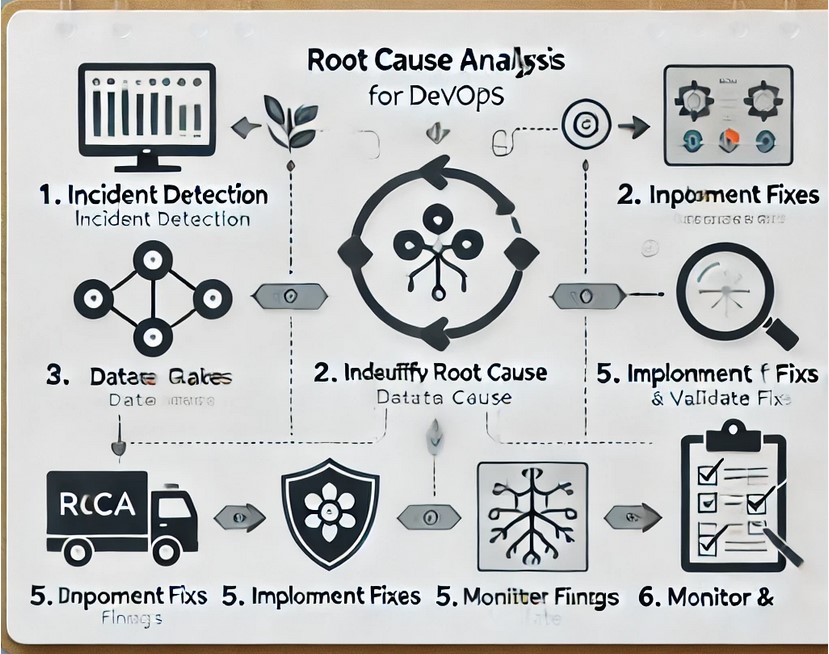Introduction
In the fast-paced DevOps environment, system failures and incidents are inevitable. However, what truly differentiates high-performing DevOps teams is how effectively they analyze and prevent recurring issues. This is where Root Cause Analysis (RCA) comes into play.
RCA is a systematic process that helps teams identify the underlying causes of failures, ensuring they are permanently resolved and do not resurface in the future. This blog will explore the best RCA strategies for DevOps, practical use cases, and how teams can implement a proactive approach to incident management.
What is Root Cause Analysis (RCA) in DevOps?
Root Cause Analysis (RCA) is the process of identifying the true source of an issue rather than just addressing its symptoms. In DevOps, RCA helps improve system stability, reduce downtime, and optimize infrastructure performance.
By understanding why an issue occurred, teams can implement permanent fixes rather than temporary workarounds, ultimately reducing future failures.
Why RCA is Critical for DevOps Teams?
-
Prevents Recurring Failures: Identifies and eliminates the root cause, reducing repeated incidents.
-
Improves System Reliability: Enhances uptime and availability by addressing critical issues.
-
Reduces Operational Costs: Mitigates financial losses from downtime and unplanned outages.
-
Encourages Collaboration: Helps teams share knowledge and improve cross-functional problem-solving.
-
Supports Continuous Improvement: Allows teams to refine processes and automation strategies.
Key Steps for Effective RCA in DevOps
Step 1: Incident Detection and Initial Response
Before performing RCA, teams must quickly detect and respond to incidents. Monitoring tools like Prometheus, New Relic, Datadog, and ELK Stack help identify anomalies in real-time.
Best Practices:
-
Set up automated alerts for unusual system behaviors.
-
Classify incidents based on severity (Critical, Major, Minor).
-
Assign an on-call team to handle immediate troubleshooting.
Step 2: Data Collection & Log Analysis
Once an incident is detected, the next step is to gather relevant data to understand what went wrong.
What to Collect?
-
Application Logs (via Fluentd, Loki, Splunk)
-
Infrastructure Logs (AWS CloudWatch, Azure Monitor)
-
Performance Metrics (Grafana, Prometheus)
-
Recent Deployment History (CI/CD logs)
-
User Reports & Error Messages
Pro Tip: Implement centralized logging to simplify RCA investigations.
Step 3: Identifying the Root Cause
The most crucial part of RCA is pinpointing the exact reason behind the failure. Teams use multiple RCA techniques for this:
The 5 Whys Method: Keep asking “Why?” until you uncover the root cause.
Ishikawa (Fishbone) Diagram: Categorizes potential causes (Software, Infrastructure, Process, Human Error).
Change Analysis: Compares system states before and after the incident.
Blameless Post-Mortem: Encourages open discussion without assigning blame.
Example: If a database query caused a service outage, ask:
-
Why did the query fail? → High latency.
-
Why was there high latency? → Table scan on large data.
-
Why was the table scan happening? → Missing index.
-
Why was the index missing? → It was removed in a recent deployment.
-
Why was it removed? → Deployment rollback did not restore indexes.
Step 4: Implementing a Permanent Fix
Once the root cause is identified, teams must apply corrective measures to prevent the issue from occurring again.
Types of Fixes:
Immediate Fix: Quick patches to restore services.
Long-Term Fix: Permanent code, infrastructure, or workflow improvements.
Process Improvements: Updating CI/CD pipelines, access control, or automation rules.
Example Fix for Database Query Failure:
-
Immediate Fix: Reintroduce the missing index.
-
Long-Term Fix: Automate database migration validation in CI/CD.
Pro Tip: Automate RCA documentation using DevOps tools like Jira, Confluence, or GitHub Wiki.
Step 5: Documentation & Knowledge Sharing
A well-documented RCA report ensures that lessons learned from incidents benefit the entire organization.
Key Elements of an RCA Report:
Incident Summary – What happened?
Timeline of Events – When and how it unfolded?
Root Cause – What was the main issue?
Resolution – Steps taken to fix it.
Preventive Measures – How to stop it from happening again?






